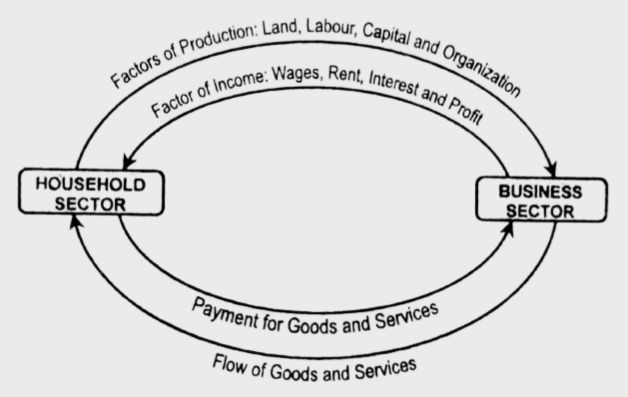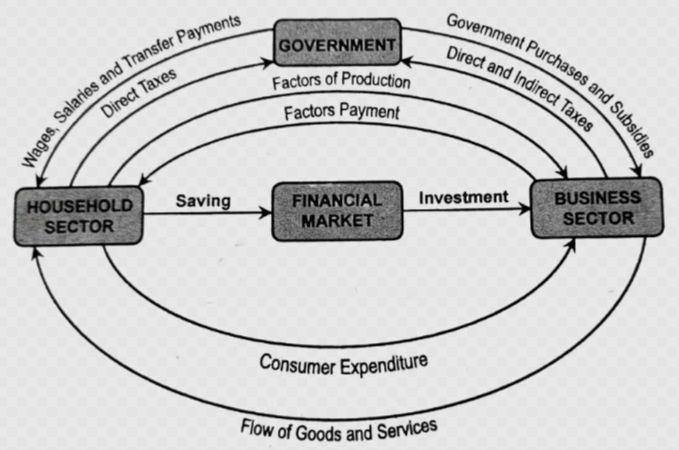2.1 Circular Flow of Income & Expenditure in Two Sector, Three Sector and Four Sector Economy
Macroeconomics को Unit 2 को first chapter मा तपाईंलाई स्वागत छ। यो chapter को notes पढिसकेपछि तपाईंले यी कुराहरु सिक्नुहुनेछ।
-
Circular Flow of Income & Expenditure भनेको के हो?
-
अनि 2 Sector, 3 Sector र 4 Sector Economy मा Circular Flow of Income & Expenditure कस्तो टाइपको हुन्छ?
(Note: अलि सम्झनको लागि माथिको प्रत्येक points को अगाडिको circle मा click गर्दै आउनुहोस्।)

Circle मा click गरिसक्यौं, अब हामी त Notes पढ्न लागेको!
अनि Notes हरु चाहिं syllabus अनुसार serially दिएको भएर हामी पनि serially नै पढ्न लागेको!
First मा Circular Flow of Income & Expenditure in a 2 Sector Economy बारे बुझौँ न त!
#सबभन्दा पहिला त यो Circular flow of income & expenditure भनेको के रैछ, त्यो बुझौँ!
→ Circular flow of income and expenditure एउटा त्यस्तो model हो जसले how money flows between households and businesses in an economy भन्ने कुरा देखाउँछ |
→ In a circular flow, households earn income by selling their labor and other factors of production to businesses. Households then spend this money to buy goods and services produced by businesses.
→ Businesses receive this expenditure from the households and use it to pay again for factors of production
→ This way, a continuous flow of income and expenditure is created, which is known as the circular flow of income & expenditure.
#अनि अर्को कुरा चाहिं, this circular flow of income & expenditure can be measured in 3 different economic sectors:
1) Circular flow of income & expenditure in a two sector economy
2) Circular flow of income & expenditure in a three sector economy
3) Circular flow of income & expenditure in a four sector economy
#last मा जाँदाजाँदै, यो पनि थाहा पाई हालौं :
The circular flow of income and expenditure can be used to explain how GDP is calculated. GDP is the total value of all goods and services produced in an economy in a given year. The circular flow of income and expenditure shows that GDP is equal to the total income earned by households in an economy. This is because the income that households earn is used to purchase goods and services produced by businesses. Businesses then use the money they receive from households to pay for the factors of production they need to produce more goods and services. This process continues, and the total value of all goods and services produced in an economy is equal to the total income earned by households.
Circular Flow of Income & Expenditure in a Two Sector Economy
The circular flow of income and expenditure in a two sector economy is a model that shows how money flows between households and businesses. In a two sector economy, there are only two types of economic agents: households and businesses.
Assumptions:
The circular flow of income and expenditure in a two sector economy is mainly based on the following assumptions:
- There are only two sectors in the economy: household and business sectors.
- Households have the factors of production like land, labour etc and these factors are hired by the business sector to produce goods and services.
- There is no government and no international trade
On the basis of these assumptions, the circular flow of income and expenditure in a two sector economy can be shown in a figure as follows:
In the given figure, we can see the household sector and the business sector. At the top of the figure, we can see that the household sector is providing factors of production like land, labour, capital, etc to the business sector (नोट: त्यो figure को टप मा household बाट शुरु भएर business sector मा गएर टुंगिने यस्तो खालको semi-circular arrow ↷ ले देखाएको जस्तो) and in return to that, the business sector is providing wages, rent, interest, etc to the household sector (नोट: त्यो figure को टप मा business sector बाट शुरु भएर household मा गएर टुंगिने यस्तो खालको semi-circular arrow ↶ ले देखाएको जस्तो). Now using the factors of production from the household sector, the business sector starts producing different goods and services. And using the income obtained from the business sector in the form of wages, rent etc, the household sector starts buying different goods and services from the business sector. This can be seen at the bottom part of the figure below.

At the bottom of the figure, we can see that the business sector is now offering the flow of goods and services to the household sector. And the household sector is providing the payment for goods and services to the business sector. Actually, here the household sector is using the same income from the wages and rent, etc that it received from the business sector to spend in the payment for the purchased goods and services.
In this way, the circular flow of income and expenditure continues in a two sector economy.
#बुझ्नको लागि मात्रै (Summary of how the circular flow of income and expenditure works)
- Households provide labor and capital to businesses.
- Businesses use the labor and capital provided by households to produce goods and services.
- Businesses sell the goods and services they produce to households.
- Households spend money to buy goods and services from the businesses.
- When households spend money for purchasing goods, the businesses receive income which they again spend to produce more goods and services.
- The circular flow of income and expenditure continues in this way.
अब Circular Flow of Income & Expenditure in Three Sector Economy को पालो
Circular Flow of Income & Expenditure in a Three Sector Economy
The circular flow of income and expenditure in a three sector economy is a model that shows how money flows among households, government and businesses. In a three sector economy, there are only three types of economic agents: households, government and businesses. It is more realistic than the two sector economy as it also includes government which has a significant role in the economy.
Assumptions:
The circular flow of income and expenditure in a three sector economy is mainly based on the following assumptions:
- There are only three sectors in the economy: household, business and government sector.
- There is government intervention (govt को हस्तक्षेपकारी भूमिका) in economic activities
- Government imposes taxes and grants subsidies
- There is a perfectly competitive market.
- There is no international trade in the economy (i.e. no export and import)
- Businesses pay both direct and indirect tax to the government while households pay only direct tax.
On the basis of these assumptions, the circular flow of income and expenditure in a three sector economy can be shown in a figure as follows:

The above figure shows the circular flow of income and expenditure in a three sector economy consisting of household, business and government sectors. Let’s look at how these sectors interact and exchange money and goods among themselves in a three sector economy model.
1. Household and Government Sectors:
- Households pay taxes to governments, which reduces what they can spend and save.
- But the government also gives money to households in the form of wages, salaries etc for hiring their services. Next, the government gives financial support to households known as transfer payments (e.g. financial aid to low-income families or single parents, old age allowance, govt-sponsored scholarship, etc) This activity adds money back into the economy causing a circular flow of income and expenditure.
2. Business and Government Sectors:
- Businesses pay taxes to the government, reducing their earnings (In economic terms, this is called leakage).
- But the government also supports businesses through government purchases and subsidies i.e. by buying goods from them and providing subsidies to them. This adds money back into the economy ( also known as injection of money).
3. Household, Business and Govt. Sectors:
- As already observed, paying taxes to government decreases consumption and saving of households. This decrease in consumption, in turn, reduces the sales and income of businesses. Also, for the businesses, paying tax to the government reduces their investment & production. However, To keep the economy in balance, the government spends the tax money it collects by paying for services from households along with transfer payments, and buying goods and services from businesses. This helps in maintaining a stable circular flow of income and expenditure in a three sector economy.
अब लास्टमा Circular Flow of Income & Expenditure in Four Sector Economy बारे पनि भन्दिनुस न!
Circular Flow of Income & Expenditure in a Four Sector Economy
The circular flow of income and expenditure in a four sector economy is a model that shows how money flows among households, businesses, government, and the foreign sector. In a four sector economy, there are four types of economic agents: households, businesses, government and the foreign sector. It is formed by adding the foreign sector to the three sector economy and it therefore studies all sectors of the economy.
Assumptions:
The circular flow of income and expenditure in a four sector economy is mainly based on the following assumptions:
- There are four sectors in the economy: household, business, government, and the foreign sector.
- There is a minimum government intervention (govt को न्यून हस्तक्षेपकारी भूमिका) in economic activities
- There is no restriction on international trade i.e. in import and export.
- There is a perfectly competitive market, both internally and externally.
- The household sector exports only labor and capital.
- The business sector imports and exports only goods and services.
On the basis of these assumptions, the circular flow of income and expenditure in a four sector economy can be shown in a figure as follows:

The above figure shows the circular flow of income and expenditure in a four sector economy consisting of household, business, government, and the foreign sector. Let’s look at how these sectors interact and exchange money and goods among themselves in a four sector economy model.
- Household Sector: People work for foreign countries and get paid. This money comes into the economy in the form of remittance and is called inflow. On the other hand, people buy imported goods, which sends money out of the economy, called outflow.
- Business Sector: Businesses sell goods to foreign countries and get paid i.e they get paid for exports. This money is an inflow. However, businesses also buy things from foreign countries like materials and equipment and make payment for the import of these goods, which is an outflow.
- Government Sector: The government also trades with foreign countries. It sells goods and services, gets investments, and receives financial help, which is an inflow. On the other hand, the government buys goods and pays for foreign investments, which causes money to go out, called outflow.
- Foreign Sector: Foreign countries buy goods and services from our businesses and households, and they pay for it, which is an inflow for our economy. But they also sell goods and services to our businesses and government, which is an outflow for our economy.
In this way, there is a continuous, circular flow of money among these four sectors in the economy. Inflow is when money comes in, and outflow is when money goes out.
FLASH CARD मा CHAPTER SUMMARY
अब यो Circular Flow of Income & Expenditure in Two Sector, Three Sector र Four Sector Economy बारे जुन Notes हामीले पढ्यौं नि, त्यसलाई सम्झनको लागि एकपटक तलको Card मुनिको “Flip Card” मा click गरि हेर्नुहोस्।
○○○ के रहेछ त circular flow of income & expenditure in a 2 sector economy भनेको?
The circular flow of income & expenditure in a 2 sector economy is a model that shows how money flows between households and businesses.
सम्झन सक्नुहुन्छ त circular flow of income & expenditure in a 2 sector economy भनेको?
The circular flow of income & expenditure in a 3 sector economy is a model that shows how money flows among households, government and businesses.
○○○ अनि यो 4 sector वाला नमुना 🙂 याद छ त?
The circular flow of income & expenditure in a 4 sector economy is a model that shows how money flows among households, businesses, government, and the foreign sector.
तपाईं अहिले TU Solution भन्ने tab मा हुनुहुन्छ
यहाँ तपाईंले यस chapter बाट अहिलेसम्म TU मा सोधिएका सबै question र त्यसको solution पाउनसक्नुहुन्छ। Question हरु chapter को topics अनुसार serially राखिएको छ।
ये ये! अनि एउटा question – हामीलाई अझै practice को लागि extra question हरु पनि भएको भए हुन्थ्यो नि, त्यस्तो छ र Owl दाई?

#के भन्नु हुन्छ त तपाईंको Owl दाईले?
Show MoreGroup A – Brief Answer Questions
Group A को लागि Chapterwise TU Solution
Circular Flow of Income & Expenditure in Two Sector Economy
Q) What do you mean by a two sector economy?
→ The economy which consists of only two sectors – households and businesses – is called a two sector economy. It is not a realistic model of the economy and is also known as two sector closed economy.
Circular Flow of Income & Expenditure in Three Sector Economy
Q) What do you mean by a three sector economy?
→ The economy which consists of only three sectors – households, businesses, and government – is called a three sector economy. It is also known as the three sector closed economy.
Q) What do you mean by a closed economy?
→ The economy which is not engaged in any international trade is called a closed economy.
Circular Flow of Income & Expenditure in Four Sector Economy
Q) What do you mean by a four sector economy?
→ The economy which consists of four sectors – households, businesses, government, and foreign sector – is called a four sector economy. It is also known as the open economy.
Q) What do you mean by open economy?
→ The economy which is engaged in any international trade is called an open economy. It is also known as the four sector economy.
Q) What are the leakages and injections in the circular flow of income and expenditure?
→ In the circular flow of income and expenditure, the leakages are the savings, taxes, and imports whereas the injections are the investments, government spending and exports.
#कसरी भयो त त्यस्तो ? हल्का बुझौँ है त !
✓ Leakages: Leakages refer to the outflow of money i.e money flowing out of the circular flow. This reduces the total income in the economy. The three main types of leakages are savings (when people save money instead of spending it), taxes (when the government takes money from households and businesses), and imports (when people buy goods and services from foreign countries).
✓ Injections: Injections refer to the inflow of money i.e money flowing into the circular flow. This increases the total income in the economy. The three main types of injections are investments (when businesses spend money to buy capital goods and expand), government spending (when the government buys goods and services from businesses), and exports (when foreign countries buy goods and services from our businesses).
Hey, Great Going!
Looks like you are on your way to becoming a super learner soon.

Group B – Descriptive Answer Questions
Group B को लागि Chapterwise TU Solution
Circular Flow of Income & Expenditure in Two Sector Economy
#एकपटक Circular flow of income & expenditure भनेको के रैछ, बुझौँ!
→ Circular flow of income and expenditure एउटा त्यस्तो model हो जसले how money flows between households and businesses in an economy भन्ने कुरा देखाउँछ |
→ In a circular flow, households earn income by selling their labor and other factors of production to businesses. Households then spend this money to buy goods and services produced by businesses.
→ Businesses receive this expenditure from the households and use it to pay again for factors of production
→ This way, a continuous flow of income and expenditure is created, which is known as the circular flow of income & expenditure.
#अनि अर्को कुरा चाहिं, this circular flow of income & expenditure can be measured in 3 different economic sectors:
1) Circular flow of income & expenditure in a two sector economy
2) Circular flow of income & expenditure in a three sector economy
3) Circular flow of income & expenditure in a four sector economy
#last मा जाँदाजाँदै, यो पनि थाहा पाई हालौं :
The circular flow of income and expenditure can be used to explain how GDP is calculated. GDP is the total value of all goods and services produced in an economy in a given year. The circular flow of income and expenditure shows that GDP is equal to the total income earned by households in an economy. This is because the income that households earn is used to purchase goods and services produced by businesses. Businesses then use the money they receive from households to pay for the factors of production they need to produce more goods and services. This process continues, and the total value of all goods and services produced in an economy is equal to the total income earned by households.
Q) Explain the circular flow of income and expenditure in a two sector economy. [2077 Q.No.12]
Circular Flow of Income & Expenditure in a Two Sector Economy
The circular flow of income and expenditure in a two sector economy is a model that shows how money flows between households and businesses. In a two sector economy, there are only two types of economic agents: households and businesses.
Assumptions:
The circular flow of income and expenditure in a two sector economy is mainly based on the following assumptions:
- There are only two sectors in the economy: household and business sectors.
- Households have the factors of production like land, labour etc and these factors are hired by the business sector to produce goods and services.
- There is no government and no international trade
On the basis of these assumptions, the circular flow of income and expenditure in a two sector economy can be shown in a figure as follows:
In the given figure, we can see the household sector and the business sector. At the top of the figure, we can see that the household sector is providing factors of production like land, labour, capital, etc to the business sector (नोट: त्यो figure को टप मा household बाट शुरु भएर business sector मा गएर टुंगिने यस्तो खालको semi-circular arrow ↷ ले देखाएको जस्तो) and in return to that, the business sector is providing wages, rent, interest, etc to the household sector (नोट: त्यो figure को टप मा business sector बाट शुरु भएर household मा गएर टुंगिने यस्तो खालको semi-circular arrow ↶ ले देखाएको जस्तो). Now using the factors of production from the household sector, the business sector starts producing different goods and services. And using the income obtained from the business sector in the form of wages, rent etc, the household sector starts buying different goods and services from the business sector. This can be seen at the bottom part of the figure below.

At the bottom of the figure, we can see that the business sector is now offering the flow of goods and services to the household sector. And the household sector is providing the payment for goods and services to the business sector. Actually, here the household sector is using the same income from the wages and rent, etc that it received from the business sector to spend in the payment for the purchased goods and services.
In this way, the circular flow of income and expenditure continues in a two sector economy.
#बुझ्नको लागि मात्रै (Summary of how the circular flow of income and expenditure works)
- Households provide labor and capital to businesses.
- Businesses use the labor and capital provided by households to produce goods and services.
- Businesses sell the goods and services they produce to households.
- Households spend money to buy goods and services from the businesses.
- When households spend money for purchasing goods, the businesses receive income which they again spend to produce more goods and services.
- The circular flow of income and expenditure continues in this way.
Circular Flow of Income & Expenditure in Three Sector Economy
Q) Explain the circular flow of income and expenditure in a three sector economy.
Circular Flow of Income & Expenditure in a Three Sector Economy
The circular flow of income and expenditure in a three sector economy is a model that shows how money flows among households, government and businesses. In a three sector economy, there are only three types of economic agents: households, government and businesses. It is more realistic than the two sector economy as it also includes government which has a significant role in the economy.
Assumptions:
The circular flow of income and expenditure in a three sector economy is mainly based on the following assumptions:
- There are only three sectors in the economy: household, business and government sector.
- There is government intervention (govt को हस्तक्षेपकारी भूमिका) in economic activities
- Government imposes taxes and grants subsidies
- There is a perfectly competitive market.
- There is no international trade in the economy (i.e. no export and import)
- Businesses pay both direct and indirect tax to the government while households pay only direct tax.
On the basis of these assumptions, the circular flow of income and expenditure in a three sector economy can be shown in a figure as follows:

The above figure shows the circular flow of income and expenditure in a three sector economy consisting of household, business and government sectors. Let’s look at how these sectors interact and exchange money and goods among themselves in a three sector economy model.
1. Household and Government Sectors:
- Households pay taxes to governments, which reduces what they can spend and save.
- But the government also gives money to households in the form of wages, salaries etc for hiring their services. Next, the government gives financial support to households known as transfer payments (e.g. financial aid to low-income families or single parents, old age allowance, govt-sponsored scholarship, etc) This activity adds money back into the economy causing a circular flow of income and expenditure.
2. Business and Government Sectors:
- Businesses pay taxes to the government, reducing their earnings (In economic terms, this is called leakage).
- But the government also supports businesses through government purchases and subsidies i.e. by buying goods from them and providing subsidies to them. This adds money back into the economy ( also known as injection of money).
3. Household, Business and Govt. Sectors:
- As already observed, paying taxes to government decreases consumption and saving of households. This decrease in consumption, in turn, reduces the sales and income of businesses. Also, for the businesses, paying tax to the government reduces their investment & production. However, To keep the economy in balance, the government spends the tax money it collects by paying for services from households along with transfer payments, and buying goods and services from businesses. This helps in maintaining a stable circular flow of income and expenditure in a three sector economy.
Circular Flow of Income & Expenditure in Four Sector Economy
Q) Explain the circular flow of income and expenditure in a four sector economy.
Circular Flow of Income & Expenditure in a Four Sector Economy
The circular flow of income and expenditure in a four sector economy is a model that shows how money flows among households, businesses, government, and the foreign sector. In a four sector economy, there are four types of economic agents: households, businesses, government and the foreign sector. It is formed by adding the foreign sector to the three sector economy and it therefore studies all sectors of the economy.
Assumptions:
The circular flow of income and expenditure in a four sector economy is mainly based on the following assumptions:
- There are four sectors in the economy: household, business, government, and the foreign sector.
- There is a minimum government intervention (govt को न्यून हस्तक्षेपकारी भूमिका) in economic activities
- There is no restriction on international trade i.e. in import and export.
- There is a perfectly competitive market, both internally and externally.
- The household sector exports only labor and capital.
- The business sector imports and exports only goods and services.
On the basis of these assumptions, the circular flow of income and expenditure in a four sector economy can be shown in a figure as follows:

The above figure shows the circular flow of income and expenditure in a four sector economy consisting of household, business, government, and the foreign sector. Let’s look at how these sectors interact and exchange money and goods among themselves in a four sector economy model.
- Household Sector: People work for foreign countries and get paid. This money comes into the economy in the form of remittance and is called inflow. On the other hand, people buy imported goods, which sends money out of the economy, called outflow.
- Business Sector: Businesses sell goods to foreign countries and get paid i.e they get paid for exports. This money is an inflow. However, businesses also buy things from foreign countries like materials and equipment and make payment for the import of these goods, which is an outflow.
- Government Sector: The government also trades with foreign countries. It sells goods and services, gets investments, and receives financial help, which is an inflow. On the other hand, the government buys goods and pays for foreign investments, which causes money to go out, called outflow.
- Foreign Sector: Foreign countries buy goods and services from our businesses and households, and they pay for it, which is an inflow for our economy. But they also sell goods and services to our businesses and government, which is an outflow for our economy.
In this way, there is a continuous, circular flow of money among these four sectors in the economy. Inflow is when money comes in, and outflow is when money goes out.
Group C – Analytical Answer Questions
Group C को लागि Chapterwise TU Solution
